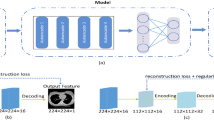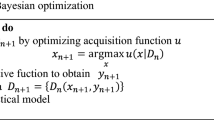Abstract
Background
The SARS-CoV-2 virus, which caused the COVID-19 pandemic, emerged in late 2019, leading to significant global health challenges due to the lack of targeted treatments and the need for rapid diagnosis.
Aim/objective
This study aims to develop an AI-based system to accurately detect COVID-19 from CT scans, enhancing the diagnostic process.
Methodology
We employ a faster region-based convolutional neural network (faster R-CNN) for extracting features from pre-processed CT images and use the chaotic satin bowerbird optimization algorithm (CSBOA) for fine-tuning the model parameters.
Results
Our experimental results show high performance in terms of precision, recall, accuracy, and f-measure, effectively identifying COVID-19 affected areas in CT images. The suggested model attained 91.78% F1-score, 91.37% accuracy, 91.87% precision, and 90.3% recall with a learning rate of 0.0001.
Conclusion
This method contributes to the advancement of AI-driven diagnostic tools, providing a pathway for improved early detection and treatment strategies for COVID-19, thus aiding in better clinical management.






Similar content being viewed by others
Explore related subjects
Discover the latest articles and news from researchers in related subjects, suggested using machine learning.Change history
16 October 2024
A Correction to this paper has been published: https://doi.org/10.1007/s00354-024-00284-z
References
Shahin, O.R., Alshammari, H.H., Taloba, A.I., Abd El-Aziz, R.M.: Machine learning approach for autonomous detection and classification of COVID-19 virus. Comput. Electr. Eng.. Electr. Eng. 101, 108055 (2022)
Iwendi, C., Mahboob, K., Khalid, Z., Javed, A.R., Rizwan, M., Ghosh, U.: Classification of COVID-19 individuals using adaptive neuro-fuzzy inference system. Multimed. Syst. (2022). https://doi.org/10.1007/s00530-021-00774-w
Lu, S., Zhu, Z., Gorriz, J.M., Wang, S.H., Zhang, Y.D.: NAGNN: classification of COVID-19 based on neighboring aware representation from deep graph neural network. Int. J. Intell. Syst.Intell. Syst. 37(2), 1572–1598 (2022)
Althenayan, A.S., AlSalamah, S.A., Aly, S., Nouh, T., Mirza, A.A.: Detection and classification of COVID-19 by radiological imaging modalities using deep learning techniques: a literature review. Appl. Sci. 12(20), 10535 (2022)
Bhandari, M., Shahi, T.B., Siku, B., Neupane, A.: Explanatory classification of CXR images into COVID-19, Pneumonia and Tuberculosis using deep learning and XAI. Comput. Biol. Med.. Biol. Med. 1(150), 106156 (2022)
Barshooi, A.H., Amirkhani, A.: A novel data augmentation based on Gabor filter and convolutional deep learning for improving the classification of COVID-19 chest X-Ray images. Biomed. Signal Process. Control 72, 103326 (2022)
Malik, H., Anees, T.: BDCNet: Multi-classification convolutional neural network model for classification of COVID-19, pneumonia, and lung cancer from chest radiographs. Multimed. Syst. 28(3), 815–829 (2022)
Kumar, R., Arora, R., Bansal, V., Sahayasheela, V.J., Buckchash, H., Imran, J., et al.: Classification of COVID-19 from chest x-ray images using deep features and correlation coefficient. Multimed. Tools Appl. 81(19), 27631–27655 (2022)
Amin, J., Anjum, M.A., Sharif, M., Rehman, A., Saba, T., Zahra, R.: Microscopic segmentation and classification of COVID-19 infection with ensemble convolutional neural network. Microsc. Res. Tech.. Res. Tech. 85(1), 385–397 (2022)
Baghdadi, N.A., Malki, A., Abdelaliem, S.F., Balaha, H.M., Badawy, M., Elhosseini, M.: An automated diagnosis and classification of COVID-19 from chest CT images using a transfer learning-based convolutional neural network. Comput. Biol. Med.. Biol. Med. 144, 105383 (2022)
Ayalew, A.M., Salau, A.O., Abeje, B.T., Enyew, B.: Detection and classification of COVID-19 disease from X-ray images using convolutional neural networks and histogram of oriented gradients. Biomed. Signal Process. Control Signal Process. Control 74, 103530 (2022)
Pustokhin, D.A., Pustokhina, I.V., Dinh, P.N., Phan, S.V., Nguyen, G.N., Joshi, G.P.K.S.: An effective deep residual network based class attention layer with bidirectional LSTM for diagnosis and classification of COVID-19. J. Appl. Stat. 50(3), 477–494 (2023)
Kumar, S., Gupta, S.K., Kumar, V., Kumar, M., Chaube, M.K., Naik, N.S.: Ensemble multimodal deep learning for early diagnosis and accurate classification of COVID-19. Comput. Electr. Eng.. Electr. Eng. 103, 108396 (2022)
Aggarwal, P., Mishra, N.K., Fatimah, B., Singh, P., Gupta, A., Joshi, S.D.: COVID-19 image classification using deep learning: advances, challenges and opportunities. Comput. Biol. Med.. Biol. Med. 144, 105350 (2022)
Kumar, S., Chaube, M.K., Alsamhi, S.H., Gupta, S.K., Guizani, M., Gravina, R., Fortino, G.: A novel multimodal fusion framework for early diagnosis and accurate classification of COVID-19 patients using X-ray images and speech signal processing techniques. Comput. Methods Programs Biomed.. Methods Programs Biomed. 226, 107109 (2022)
Samee, N.A., El-Kenawy, E.S.M., Atteia, G., Jamjoom, M.M., Ibrahim, A., Abdelhamid, A.A., et al.: Metaheuristic optimization through deep learning classification of COVID-19 in chest X-ray images. Comput. Mater. Contin. 73(2), 4193–4210 (2022)
Zhou, W., Wang, J., Wang, Y., Liu, Z., Yang, C.: CGS-Net: A classification-guided framework for automated infection segmentation of COVID-19 from CT images. Int. J. Imaging Syst. Technol. 34(1), e23021 (2024)
Sahoo, P., Saha, S., Sharma, S.K., Mondal, S., Gowda, S.: A Multi-stage framework for COVID-19 detection and severity assessment from chest radiography images using advanced fuzzy ensemble technique. Expert Syst. Appl. 238, 121724 (2024)
Salazar-Urbina, A., Ventura-Molina, E.J., Yáñez-Márquez, C., Aldape-Pérez, M., López-Yáñez, I.: MiniCovid-Unet: CT-scan lung images segmentation for COVID-19 identification. Comput Sist (2024). https://doi.org/10.13053/cys-28-1-4697
Shankar, K., Mohanty, S.N., Yadav, K., Gopalakrishnan, T.: Automated COVID-19 diagnosis and classification using convolutional neural network with fusion-based feature extraction model. Cogn. Neurodyn. 16(1) (2021). https://doi.org/10.1007/s11571-021-09712-y. ISSN: 1871-4099
Amin, J., Anjum, M.A., Gul, N., Sharif, M.I., Sharif, M.I., Kadry, S.: Localization model and rank-based features selection approach for the classification of GGO and consolidation stages of COVID-19. Expert Syst. Appl. 239, 122317 (2024)
Divya, D., Thilagu, M.: Region growing based K-means clustering and optimal weight prior-attention residual learning for segmentation and classification of COVID-19 CT images. ECTI Trans Comput Inf Technol 18(1), 76–88 (2024)
Ağralı, M., Kılıç, V.: U-TranSvision: transformer-based deep supervision approach for COVID-19 lesion segmentation on computed tomography images. Biomed. Signal Process. Control 93, 106167 (2024)
Alhassan, A.M.: Thresholding chaotic butterfly optimization algorithm with gaussian kernel (TCBOGK) based segmentation and DeTrac deep convolutional neural network for COVID-19 X-ray images. Multimed. Tools Appl. 83, 1–24 (2024)
O. Paiva, Helping radiologists to help people in more than 100 countries! coronavirus cases, CORONACASES.ORG, 2020
Y. Glick, Viewing playlist: COVID-19 Pneumonia, Radiopaedia.Org. 2020
M. Jun, G. Cheng, W. Yixin, A. Xingle, G. Jiantao, Y. Ziqi, Z. Minqing, L. Xin, D. Xueyuan, C. Shucheng, W. Hao, M. Sen, Y. Xiaoyu, N. Ziwei, L. Chen, T. Lu, Z. Yuntao, Z. Qiongjie, D. Guoqiang, H. Jian, COVID-19 CT lung and infection segmentation dataset, Zenodo, Ed., Verson 1.0 ed, 2020
Baswaraju, S., Maheswari, V.U., Chennam, K.K., Thirumalraj, A., Kantipudi, M.P., Aluvalu, R.: Future food production prediction using AROA based hybrid deep learning model in agri-sector. Human-Centric Intell. Syst. 3(4), 521–536 (2023)
Ara, S., Das, A., Dey, A.: Malignant and benign breast cancer classification using machine learning algorithms. In: Proceedings of the 2021 international conference on artificial intelligence (ICAI), Islamabad, Pakistan, pp. 97–101. (2021)
Moosavi, S.H.S., Bardsiri, V.K.: Satin bowerbird optimizer: a new optimization algorithm to optimize ANFIS for software development effort estimation. Eng. Appl. Artif. Intell.Artif. Intell. 60, 1–15 (2017)
Agarwal, N., Mohanty, S.N., Sankhwar, S., et al.: A novel model to predict the effects of enhanced students’ computer interaction on their health in COVID-19 pandemics. New Gen. Comput. 41, 635–668 (2023). https://doi.org/10.1007/s00354-023-00224-3
Satapathy, S.K., Saravanan, S., Mishra, S., Mohanty, S.N.: A comparative analysis of multidiemnsional COVID-19 poverty determinants: an observational machine learning approach. New Gen Comput (2023). https://doi.org/10.1007/s00354-023-00203-8
Sah, S., Surendiran, Dhanalakshmi, R., Mohanty, S.N., Alenezi, F., Polat, K.: Forecasting COVID-19 pandemic using prophet, ARIMA, and hybrid stacked LSTM-GRU models in India. Comput. Math. Methods Med.. Math Methods Med. 2022, 1556025 (2022). https://doi.org/10.1155/2022/1556025
Shome, D., Kar, T., Mohanty, S.N., Tiwari, P., Muhammad, K., AlTameem, A., Zhang, Y., Jilani Saudagar, A.K.: COVID-Transformer: interpretable COVID-19 detection using vision transformer for healthcare. Int. J. Environ. Res. Public Health 18(21), 1–14 (2021). https://doi.org/10.3390/ijerph182111086
Mishra, S., Satapathy, S.K., Cho, S.B., Mohanty, S.N., et al.: Advancing COVID-19 poverty estimation with satellite imagery-based deep learning techniques: a systematic review. Spat. Inf. Res. (2024). https://doi.org/10.1007/s41324-024-00584-y
Palaniappana, R.: Post-covid trends in manufacturing sector and its implications for businesses and policymakers. J. Eng. Manag. Inf. Technol. 2(1), 9–15 (2024). https://doi.org/10.61552/JEMIT.2024.01.002
Shankar, K., Mohanty, S.N., Yadav, K., Gopalakrishnan, T.: Automated COVID-19 diagnosis and classification using convolutional neural network with fusion based feature extraction model. Cogn. Neurodyn. Neurodyn (2021). https://doi.org/10.1007/s11571-021-09712-y
Funding
No funding associate with this research work.
Author information
Authors and Affiliations
Corresponding author
Ethics declarations
Conflict of Interests
There is no conflict of interest among the authors.
Ethical approval
No ethical approval needs for this study.
Additional information
Publisher's Note
Springer Nature remains neutral with regard to jurisdictional claims in published maps and institutional affiliations.
The original online version of this article was revised to correct the third author affiliation.
About this article
Cite this article
Uma Maheswari, V., Stephe, S., Aluvalu, R. et al. Chaotic Satin Bowerbird Optimizer Based Advanced AI Techniques for Detection of COVID-19 Diseases from CT Scans Images. New Gener. Comput. 42, 1065–1087 (2024). https://doi.org/10.1007/s00354-024-00279-w
Received:
Accepted:
Published:
Issue Date:
DOI: https://doi.org/10.1007/s00354-024-00279-w




